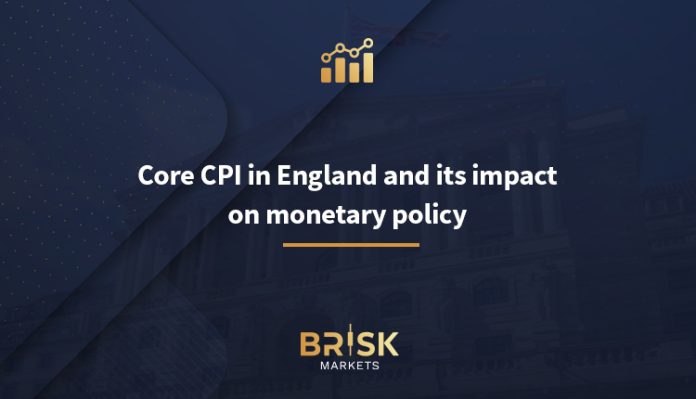
The core consumer price index (CPI) y/y is a measure of the change in the British pound’s core inflation rate (GBP) over a 12-month period. The core CPI excludes food and energy prices, which can be volatile and distort the direction of core inflation. The Bank of England closely monitors the CPI y/y to make decisions regarding interest rates and other monetary policies aimed at controlling inflation.
In August 2023, according to the latest available data, the UK’s core CPI y/y was 6.2%. This means that the core inflation rate in the UK increased by 6.2% compared to the same month a year earlier.
The annual rise in the core CPI for the pound reflects ongoing inflationary pressures in the UK economy, even as the headline CPI, which includes food and energy, began to moderate from its peak in late 2022. The Bank of England has raised interest rates to try to bring inflation back to its 2% target.
The annual trajectory of the core CPI for sterling will be an important factor in the Bank of England’s monetary policy decisions over the coming year, as it seeks to balance controlling inflation while avoiding a hard economic downturn. Observing this metric can provide insight into the fundamental inflation dynamics in the UK.
In short, the annual CPI is a crucial economic indicator in England, reflecting the annual inflation rate and influencing a wide range of economic policies and decisions. Its modern trends and components provide insight into the economic health and living standards of the country.
CPI challenges drive GBPUSD volatility
The CPI rose 0.6% in February after a similar decline in January. Annual inflation slowed to 3.4% from 4.0%, versus 3.5% expected. The core CPI slowed to rise to 4.5%y/y in February after three months of stabilization at 5.1%.
Higher prices for services lead to core inflation. This is a very slow component, making it a marathon rather than a quick race for the Bank of England. Input prices fell 0.4% in February and fell 2.7% year-on-year. The index fell to May 2022 levels thanks to lower prices of energy, metals and a range of agricultural products.
The PPI has not shown much momentum over the past three quarters. Higher wage costs have offset the decline in input prices. A generally strong labor market allows manufacturers to regain profitability. This is not bad news for the economy because it signals business confidence, which is often self-sufficient.
Sterling rose 0.1% against the general downtrend after inflation but returned very quickly to the general downtrend against the dollar.
Inflation is one of the variables that affect central bank decisions. Now, markets are in wait-and-see mode for the outcome of the FOMC meeting on Wednesday evening and the Bank of England meeting on Thursday afternoon.
The pound fell against the US dollar over the past two weeks, as it failed to make gains after a long period of consolidation. Sterling has now erased recent gains and returned near the 1.27 level.
On the weekly timeframe, GBPUSD is near the upper border of the bearish corridor that has been in place since 2008. A breakout above that would be an important event, but the basic scenario in such cases is a reversal to the downside while holding within the range. Ranges. This week’s events have enough potential to put an end to this cohesion.
England’s Consumer Price Index (CPI) slows until April 2024
The consumer price index including housing costs for owners (CPIH) rose 3.0% in the 12 months to April 2024, down from 3.8% in the 12 months to March. On a monthly basis, the CPI increased by 0.5% in April 2024, compared to a rise of 1.2% in April 2023.
The Consumer Price Index (CPI) rose 2.3% in the 12 months to April 2024, down from 3.2% in the 12 months to March. On a monthly basis, the CPI increased by 0.3% in April 2024, compared to a rise of 1.2% in April 2023. Lower gas and electricity prices led to the largest downward contributions to the monthly change in the annual rates of both the CPI and CPI, while the largest upward contribution, partially offset by motor fuel, came with prices rising this year but falling a year ago.
The core consumer price index (excluding energy, food, alcohol and tobacco) rose 4.4% in the 12 months to April 2024, down from 4.7% in March; the annual rate of goods CPIH slowed from 0.9% to minus 0.8%, while the annual rate for CPIH services was unchanged at 6.0%.
The core CPI (excluding energy, food, alcohol and tobacco) rose 3.9% in the twelve months to April 2024, down from 4.2% in March; the annual CPI rate slowed from 0.8% to minus 0.8%, while the annual CPI rate for services decreased slightly from 6.0% to 5.9%.
The consumer price index including housing costs for owners (CPIH) rose 3.0% in the 12 months to April 2024, down from 3.8% in the 12 months to March, and down from the last peak of 9.6% in October 2022.













